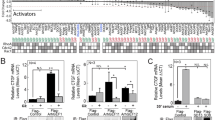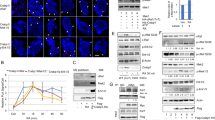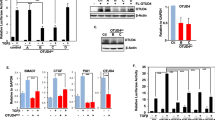Abstract
Transforming growth factor-β (TGF-β) and retinoic acid (RA) are important regulators of cell growth and differentiation. The TGF-β receptors utilize Smad proteins to transduce signals intracellularly and regulate transcription of target genes, either directly or in combination with other sequence-specific transcription factors. Two classes of nuclear receptors, the retinoic acid receptors (RARs) and the retinoic X receptors, are involved in mediating transcriptional responses to RA. Given the known interactions between the TGF-β and RAR pathways, we have investigated the role played by RAR ligands in modulating functional interactions between Smad3 and RARs. Using transient cell transfection experiments with an artificial Smad3/Smad4-dependent reporter construct, we demonstrate that RAR overexpression enhances Smad-driven transactivation, an effect that requires both Smad3 and Smad4. We provide evidence that RAR effect on Smad3/Smad4-driven transcription is prevented by natural and synthetic RAR agonists, and potentiated by synthetic RAR antagonists. The activity of two TGF-β-responsive human gene promoter constructs was regulated in a parallel fashion. Using both mammalian two-hybrid and immunoprecipitation/Western methods, we demonstrate a direct interaction between the region DEF of RARγ and the MH2 domain of Smad3, inhibited by RAR agonists and enhanced by their antagonists. We propose that RARs may function as coactivators of the Smad pathway in the absence of RAR agonists or in the presence of their antagonists, a phenomenon that contrasts with their known role as agonist-activated transcriptional regulators of RA-dependent genes.
This is a preview of subscription content, access via your institution
Access options
Subscribe to this journal
Receive 50 print issues and online access
$259.00 per year
only $5.18 per issue
Buy this article
- Purchase on Springer Link
- Instant access to full article PDF
Prices may be subject to local taxes which are calculated during checkout






Similar content being viewed by others
Abbreviations
- ATRA:
-
all-trans retinoic acid
- FCS:
-
fetal calf serum
- RA:
-
retinoic acid
- RAR:
-
retinoic acid receptor
- TGF-β:
-
transforming growth factor-β
References
Allenby G . (1995). Hum. Exp. Toxicol., 14, 226–230.
Allenby G, Bocquel MT, Saunders M, Kazmer S, Speck J, Rosenberger M, Lovey A, Kastner P, Grippo JF Chambon P and Levin AA . (1993). Proc. Natl. Acad. Sci. USA, 90, 30–34.
Attisano L and Wrana JL . (2002). Science, 296, 1646–1647.
Borger DR, Mi Y, Geslani G, Zyzak LL, Batova A, Engin TS, Pirisi L and Creek KE . (2000). Virology, 270, 397–407.
Cao Z, Flanders KC, Bertolette D, Lyakh LA, Wurthner JU, Parks WT, Letterio JJ, Ruscetti FW and Roberts AB . (2003). Blood, 101, 498–507.
Chambon P . (1996). FASEB J., 10, 940–954.
Chen JY, Penco S, Ostrowski J, Balaguer P, Pons M, Starrett JE, Reczek P, Chambon P and Gronemeyer H . (1995). EMBO J., 14, 1187–1197.
Chen X, Weisberg E, Fridmacher V, Watanabe M, Naco G and Whitman M . (1997). Nature, 389, 85–89.
Chipuk JE, Cornelius SS, Pultz NJ, Jorgenson JS, Bonham MJ, Kim SJ and Danielpour D . (2001). J. Biol. Chem., 13, 13.
Datto MB and Wang XF . (2000). Cytokine Growth Factor Rev., 11, 37–48.
Datto MB, Yu Y and Wang XF . (1995). J. Biol. Chem., 270, 28623–28628.
de Caestecker MP, Piek E and Roberts AB . (2000). J. Natl. Cancer Inst., 92, 1388–1402.
Defacque H, Sevilla C, Piquemal D, Rochette-Egly C, Marti J and Commes T . (1997). Leukemia, 11, 221–227.
Dennler S, Itoh S, Vivien D, ten Dijke P, Huet S and Gauthier JM . (1998). EMBO J., 17, 3091–3100.
Derynck R and Feng XH . (1997). Biochim. Biophys. Acta, 1333, F105–F150.
Feng XH, Lin X and Derynck R . (2000). EMBO J., 19, 5178–5793.
Fink SP, Mikkola D, Willson JK and Markowitz S . (2003). Oncogene, 22, 1317–1323.
Fu M, Zhang J, Zhu X, Myles DE, Willson TM, Liu X and Chen YE . (2001). J. Biol. Chem., 276, 45888–45894.
Germain S, Howell M, Esslemont GM and Hill CS . (2000). Genes Dev., 14, 435–451.
Gold LI . (1999). Crit. Rev. Oncogen., 10, 303–360.
Jacob K, Wach F, Holzapfel U, Hein R, Lengyel E, Buettner R and Bosserhoff AK . (1998). Melanoma Res., 8, 211–219.
Jetten AM, Kurebayashi S and Ueda E . (2001). Prog. Nucleic Acid Res. Mol. Biol., 69, 205–247.
Kumar R and Thompson EB . (1999). Steroids, 64, 310–319.
La P, Morgan TA, Sykes SM, Mao H, Schnepp RW, Petersen CD and Hua X . (2003). Oncogene, 22, 198–210.
Liberati NT, Datto MB, Frederick JP, Shen X, Wong C, Rougier-Chapman EM and Wang XF . (1999). Proc. Natl. Acad. Sci. USA, 96, 4844–4849.
Massagué J and Wotton D . (2000). EMBO J., 19, 1745–1754.
Matsuda T, Yamamoto T, Muraguchi A and Saatcioglu F . (2001). J. Biol. Chem., 276, 42908–42914.
Moustakas A and Kardassis D . (1998). Proc. Natl. Acad. Sci. USA, 95, 6733–6738.
Nagarajan RP, Liu J and Chen Y . (1999). J. Biol. Chem., 274, 31229–31235.
Nunes I, Kojima S and Rifkin DB . (1996). Cancer Res., 56, 495–499.
Pemrick SM, Lucas DA and Grippo JF . (1994). Leukemia, 8, 1797–1806.
Reiss M . (1999). Microbes Infect., 1, 1327–1347.
Roberts AB and Sporn MB . (1992). Cancer Surv., 14, 205–220.
Rodeck U, Nishiyama T and Mauviel A . (1999). Cancer Res., 59, 547–550.
Schutte M, Hruban RH, Hedrick L, Cho KR, Nadasdy GM, Weinstein CL, Bova GS, Isaacs WB, Cairns P, Nawroz H, Sidransky D, Casero Jr RA, Meltzer PS, Hahn SA and Kern SE . (1996). Cancer Res., 56, 2527–2530.
Seoane J, Pouponnot C, Staller P, Schader M, Eilers M and Massagué J . (2001). Nat. Cell Biol., 3, 400–408.
Shi Y . (2001). BioEssays, 23, 223–232.
Toma S, Isnardi L, Raffo P, Riccardi L, Dastoli G, Apfel C, LeMotte P and Bollag W . (1998). Int. J. Cancer, 78, 86–94.
Verrecchia F, Chu ML and Mauviel A . (2001a). J. Biol. Chem., 276, 17058–17062.
Verrecchia F, Vindevoghel L, Lechleider RJ, Uitto J, Roberts AB and Mauviel A . (2001b). Oncogene, 20, 3332–3340.
Vindevoghel L, Lechleider RJ, Kon A, de Caestecker MP, Uitto J, Roberts AB and Mauviel A . (1998). Proc. Natl. Acad. Sci. USA, 95, 14769–14774.
Yanagisawa J, Yanagi Y, Masuhiro Y, Suzawa M, Watanabe M, Kashiwagi K, Toriyabe T, Kawabata M, Miyazono K and Kato S . (1999). Science, 283, 1317–1321.
Acknowledgements
We are indebted to Drs A Atfi (INSERM U482, Paris, France), P Chambon, and C Rochette-Egly (IGBMC, Strasbourg, France), S Dennler and J-M Gauthier (Glaxo-Wellcome, Les Ulis, France), and CS Hill (Imperial Cancer Research Fund, London, UK) for providing us with reagents essential for these studies. This work was supported by INSERM and a research grant from Galderma R&D (Sophia-Antipolis, France) to AM. This work is dedicated to the memory of our colleague and friend Serge.
Author information
Authors and Affiliations
Corresponding author
Rights and permissions
About this article
Cite this article
Pendaries, V., Verrecchia, F., Michel, S. et al. Retinoic acid receptors interfere with the TGF-β/Smad signaling pathway in a ligand-specific manner. Oncogene 22, 8212–8220 (2003). https://doi.org/10.1038/sj.onc.1206913
Received:
Revised:
Accepted:
Published:
Issue Date:
DOI: https://doi.org/10.1038/sj.onc.1206913
Keywords
This article is cited by
-
EGR1 and RXRA transcription factors link TGF-β pathway and CCL2 expression in triple negative breast cancer cells
Scientific Reports (2021)
-
Inhibition of epithelial–mesenchymal transition in retinal pigment epithelial cells by a retinoic acid receptor-α agonist
Scientific Reports (2021)
-
Prompt meningeal reconstruction mediated by oxygen-sensitive AKAP12 scaffolding protein after central nervous system injury
Nature Communications (2014)
-
Potent inhibition of heterotopic ossification by nuclear retinoic acid receptor-γ agonists
Nature Medicine (2011)
-
SIN Retroviral Vectors Expressing COL7A1 Under Human Promoters for Ex Vivo Gene Therapy of Recessive Dystrophic Epidermolysis Bullosa
Molecular Therapy (2010)



